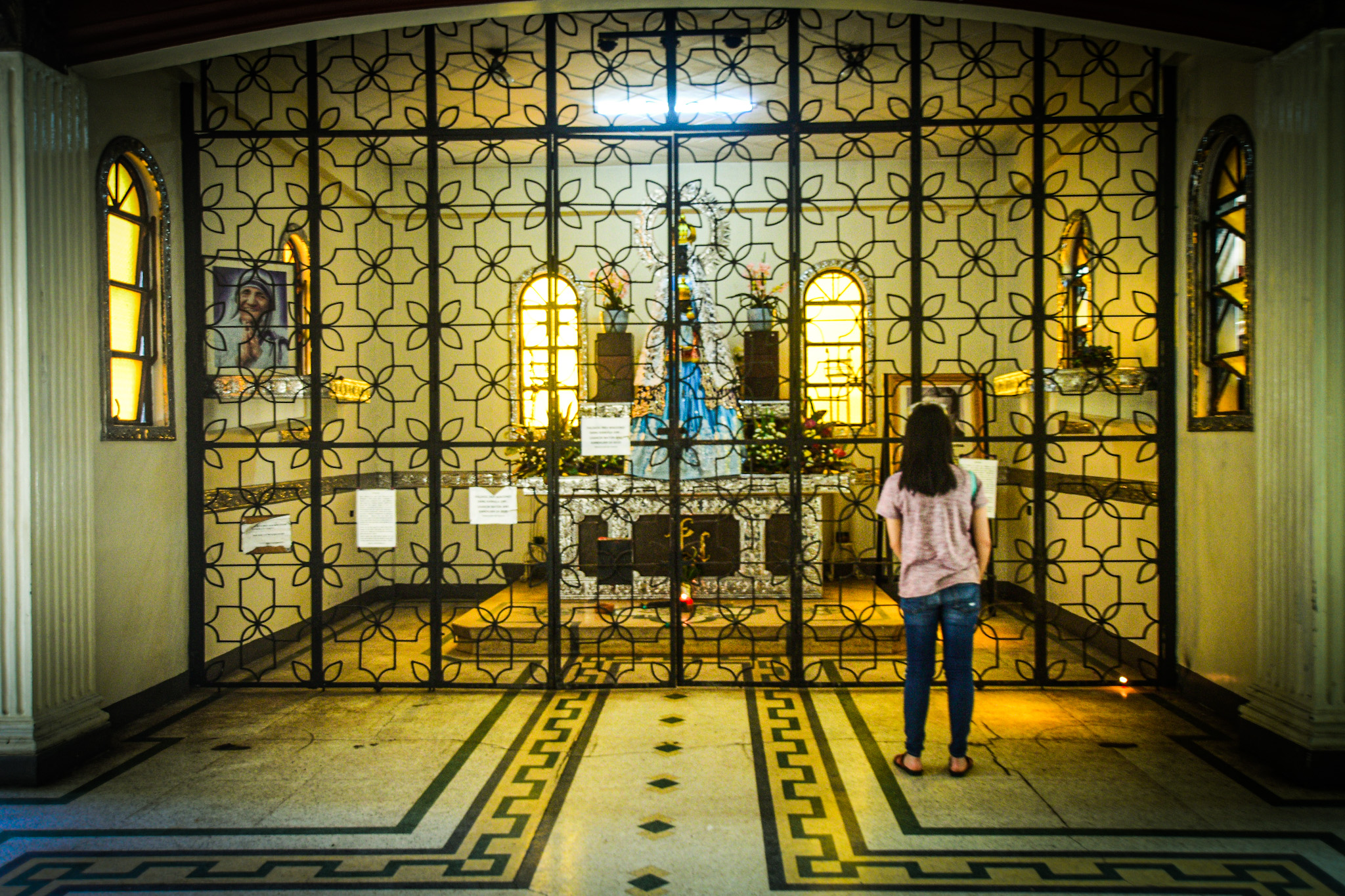In the heart of Bacolod City, the capital of Negros Occidental, is the center of spiritual direction for this province known for its vast amounts of land dedicated to sugar. Strategically located by the sea and centrally positioned where the city is divided into north and south, the San Sebastian Cathedral stands proud with its ornate towers overlooking the plaza of Bacolod City.
Being the cathedral in the province's capital, it is only fitting that this structure bears one of the most imposing facades among Negros churches. With a highly coordinated symmetry, the San Sebastian Cathedral could well denote the perfect balance of the mundane and the spiritual.
The Cathedral took its name after Pueblo de San Sebastian, the other name for this capital when it was still called Magsungay. Its full name then as a village in the 18th century was San Sebastian de Magsungay. The center of the village was a few kilometers south of the current location of the cathedral but because of attacks by the Moros, the villagers, people of Magsungay, moved up to the new settlement in the hilly terrain called "bakólod", the pre-cursor of the modern-day name, Bacolod.
The parish we now know in Bacolod grew out of a visita. A priest from another town would periodically visit to attend to the spiritual needs of the village. As it was in the 18th century, that duty fell on the parish priest of Binalbagan, or Tucguguan.
In 1806, Fr. Leon Pedro was appointed as the first parish priest of Magsungay, and years later, Fr. Julian Gonzaga, a young priest from Barcelona, would envision the construction of the San Sebastian Church for Bacolod.
Fr. Gonzaga, the parish priest from 1818-1836, constructed the original church in 1825. It was made of wood and had a galvanized iron roof. The church initially possessed a medium-sized bell. Donations of other church bells were made by Fr. Roman Manuel Locsin, who gave a large one, and Fr. Mariano de Avila, who gave another when he became the parish priest in 1863 after the death of Fr. Locsin.
The construction of the current structure began on 27 April 1876 under the leadership of Fr. Mauricio Ferrero, OAR. In constructing the stone church, prison labor was provided by the politico-military Governor, Roman Pastor, who prevailed upon Fr. Ferrero to also design and supervise the construction of a stone prison, the old Provincial Jail.
Coral stone from the island of Guimaras was used as the primary building material. Hardwood from trees in Palawan was used for wooden portions of the structure. Fr. Mariano de Avila's bell was installed in the bell tower during the church's construction.
Bishop Mariano Cuartero of the Archdiocese of Jaro consecrated the church on the eve of the feast of Saint Sebastian, 19 January 1882. Every 19th of January from then until today, the feast of St. Sebastian is celebrated as a remembrance of his martyrdom and the birth of this church.
Three years after the consecration, the construction of the two bell towers commenced with work beginning on the right tower. Don Luis Ruiz de Luzurriaga donated a large clock which was mounted on this structure. The towers were made of aluminum sheet framed in hardwood. That year, the church organ was installed in the narthex, above the church entrance.
Many more changes came about through the years. However, the pivotal moment in this church was when it was declared a cathedral when Bacolod became a diocese in 1933. The significance of the San Sebastian Cathedral has become greater as the years have gone by with one of its greatest moments in 1981 when Pope John Paul II came through its doors. Yet, through all the highlights in its history, one thing remains - the San Sebastian Cathedral, being ideally situated by the sea and with its towers hovering above the plaza of Bacolod, continues to serve as an important beacon, a lighthouse of sorts, to the spiritual lives of the citizens of modern-day Bacolod and elsewhere in the province of Negros Occidental.
In the heart of Bacolod City, the capital of Negros Occidental, is the center of spiritual direction for this province known for its vast amounts of land dedicated to sugar. Strategically located by the sea and centrally positioned where the city is divided into north and south, the San Sebastian Cathedral stands proud with its ornate towers overlooking the plaza of Bacolod City.
Being the cathedral in the province's capital, it is only fitting that this structure bears one of the most imposing facades among Negros churches. With a highly coordinated symmetry, the San Sebastian Cathedral could well denote the perfect balance of the mundane and the spiritual.
The Cathedral took its name after Pueblo de San Sebastian, the other name for this capital when it was still called Magsungay. Its full name then as a village in the 18th century was San Sebastian de Magsungay. The center of the village was a few kilometers south of the current location of the cathedral but because of attacks by the Moros, the villagers, people of Magsungay, moved up to the new settlement in the hilly terrain called "bakólod", the pre-cursor of the modern-day name, Bacolod.
The parish we now know in Bacolod grew out of a visita. A priest from another town would periodically visit to attend to the spiritual needs of the village. As it was in the 18th century, that duty fell on the parish priest of Binalbagan, or Tucguguan.
In 1806, Fr. Leon Pedro was appointed as the first parish priest of Magsungay, and years later, Fr. Julian Gonzaga, a young priest from Barcelona, would envision the construction of the San Sebastian Church for Bacolod.
Fr. Gonzaga, the parish priest from 1818-1836, constructed the original church in 1825. It was made of wood and had a galvanized iron roof. The church initially possessed a medium-sized bell. Donations of other church bells were made by Fr. Roman Manuel Locsin, who gave a large one, and Fr. Mariano de Avila, who gave another when he became the parish priest in 1863 after the death of Fr. Locsin.
The construction of the current structure began on 27 April 1876 under the leadership of Fr. Mauricio Ferrero, OAR. In constructing the stone church, prison labor was provided by the politico-military Governor, Roman Pastor, who prevailed upon Fr. Ferrero to also design and supervise the construction of a stone prison, the old Provincial Jail.
Coral stone from the island of Guimaras was used as the primary building material. Hardwood from trees in Palawan was used for wooden portions of the structure. Fr. Mariano de Avila's bell was installed in the bell tower during the church's construction.
Bishop Mariano Cuartero of the Archdiocese of Jaro consecrated the church on the eve of the feast of Saint Sebastian, 19 January 1882. Every 19th of January from then until today, the feast of St. Sebastian is celebrated as a remembrance of his martyrdom and the birth of this church.
Three years after the consecration, the construction of the two bell towers commenced with work beginning on the right tower. Don Luis Ruiz de Luzurriaga donated a large clock which was mounted on this structure. The towers were made of aluminum sheet framed in hardwood. That year, the church organ was installed in the narthex, above the church entrance.
Many more changes came about through the years. However, the pivotal moment in this church was when it was declared a cathedral when Bacolod became a diocese in 1933. The significance of the San Sebastian Cathedral has become greater as the years have gone by with one of its greatest moments in 1981 when Pope John Paul II came through its doors. Yet, through all the highlights in its history, one thing remains - the San Sebastian Cathedral, being ideally situated by the sea and with its towers hovering above the plaza of Bacolod, continues to serve as an important beacon, a lighthouse of sorts, to the spiritual lives of the citizens of modern-day Bacolod and elsewhere in the province of Negros Occidental.
-
-
Photos by Ronnie Baldonado
Video by Grilled Cheese Studios
Text by Lloyd Tronco

















0 Comments